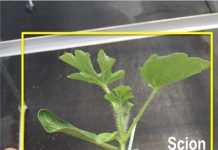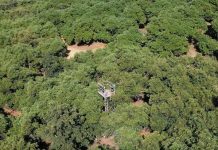
The relentless storms of 2023 set new precipitation records for California and caused widespread local flooding. “Atmospheric rivers,” or major rainstorms, between December and March and the mild temperatures that extended into spring and summer created optimal conditions that led to an unprecedented outbreak of aerial Phytophthora caused by Phytophthora syringae. Almond orchards with severe outbreaks showed numerous trees with branch dieback and cankers with profuse gumming in the upper scaffold branches of the tree. Infection commonly initiated on lateral shoots and progressed into major limbs or scaffold branches where the abundant gumming was produced. The disease was detected as early as mid-February in Fresno County and reported statewide by early summer 2023.
Almond growers should be prepared to respond to the possibility of a recurring outbreak of aerial Phytophthora. This article provides insights about the disease symptoms, the pathogen biology, as well as some management guidelines for this relatively rare but serious disease of almond.
Phytophthora syringae has been associated traditionally with aerial Phytophthora cankers in almond, also known as Phytophthora pruning wound cankers (PPWC). PPWC is characterized by cankers and profuse gumming developing at pruning wounds on branches. The disease has been recorded sporadically during wet years in almond orchards in California and can severely damage an orchard when conditions are favorable.
Early reports of PPWC date back to 1982 when the disease affected almond orchards throughout the Central Valley of California (Bostock and Doster 1985). PPWC was also commonly observed in the late 1990s and early 2000s (Greg Browne, personnel communication). High incidence of the disease generally has been correlated with heavy rainfalls typical of El Niño years such as 1982-83 and 1997-98 in California. The 2023 outbreak of aerial Phytophthora, which followed atmospheric river events, indicated inoculum of P. syringae remains abundantly present in almond orchards in California and that periodic disease outbreaks can occur when conditions are favorable. This recent outbreak also indicated the ability of this pathogen to attack young shoots of almond trees in the absence of pruning wounds. This aspect of the disease biology represents new findings for California, and a detailed description of the various symptoms associated with P. syringae is provided.
Aside from almonds, pruning wound cankers caused by P. syringae have been reported on apricots and French prunes in California (Doster and Bostock 1988d). The pathogen is also known to cause crown and collar rot of several stone fruit (including almond) and is a major cause of citrus brown rot of fruit in California (Adaskaveg et al. 2014). Aerial fruit rot of peaches and apple caused by P. syringae have been reported in Italy and England, respectively.

Disease Symptoms
Aerial Phytophthora cankers associated with P. syringae have been usually associated with pruning cuts (Figure 1) including thinning cuts made during the fall, winter or early spring. In 2023, shoot infections in the absence of pruning wounds were particularly common in almond orchards.
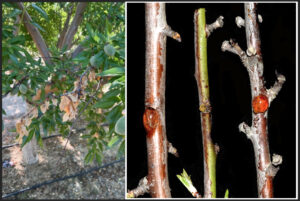
Early shoot infection causes dieback and moderate gumming (Figure 2) occurs from underlying necrotic tissues. Eventually, shoots dieback, and the disease progresses into larger branches, with new infections developing at the junction between a branch and the dead shoot. A canker is then formed, and additional gumming is produced (Figure 3). Gum balls in branches vary in color from bright amber to gold, and reddish-brown to burgundy red (Figure 4). The unique gumming appearance associated with P. syringae infections is a distinguishing feature that can help with field diagnosis of the disease.
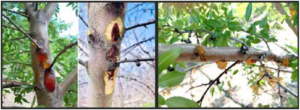
In branches, cankers generally expand quickly from an infection site (pruning wounds or shoot junction), extending to more than 6 inches within three weeks of infection. Length of cankers in branches can reach up to 16 inches or longer. Removal of the outer bark reveals distinct concentric canker margins of alternating light-brown to brown tissue (Figure 5). Infections are generally restricted to the cambium tissue and do not cause internal wood discoloration as seen with some fungal cankers. Dieback of branches can be observed in orchards; however, trees typically do not die due to infections with P. syringae. During the 2023 outbreak, disease incidence (number of trees affected) in orchards varied from 10% to 75%, although severity may differ between different sections of an orchard. Susceptible cultivars include Nonpareil, Shasta, Aldrich, Monterey and Bennett-Hickman.
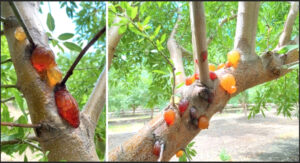
PPWC and the aerial Phytophthora are not to be confused with the Perennial Phytophthora Canker disease of almond, primarily caused by P. cactorum and P. citricola. Both diseases can cause aerial infections of almond trees, however P. syringae infections are annual, nonlethal to entire trees and associated with pruning wounds or young shoots. In contrast, perennial Phytophthora cankers are typically year-round, lethal to trees, and associated with water holding pockets and cracks at the tree crotch. Additionally, cankers caused by P. syringae can easily be mistaken for common fungal canker diseases affecting almond trees, such as Ceratocystis canker caused by Ceratocystis destructans and band canker caused by Botryosphaeriaceae fungi.
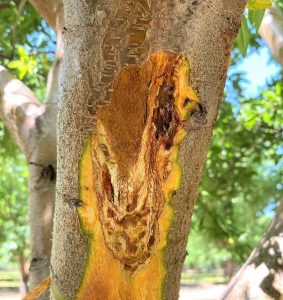
Phytophthora Species Biology
Phytophthora species were once considered fungi but are now classified in a separate kingdom, the Stramenopila, in the phylum Oomycota. Phytophthora species are soil-inhabiting plant pathogens that thrive under wet environmental conditions, hence the common name of “water molds” is often used to describe these organisms. Diseases caused by Phytophthora pathogens result in devastating losses to agriculture crops and native forests. Phytophthora species have a cell wall composition, cytoplasmic organelles and biochemical processes that are different than that of true fungi. Thus, fungicides that target true fungi are ineffective for the management of Phytophthora species. Phytophthora species can survive dry periods through the formation of oospores (sexual spores) or chlamydospores (asexual spores). These are hardy, thick-walled spores tolerant of unfavorable environmental conditions (i.e., drought, heat) and serve as survival structures for Phytophthora species. Under favorable environmental conditions (i.e., wet, cool) these survival structures can germinate to develop sporangia (sac-like structures) that form and release zoospores (asexual swimming spores). Oospores, chlamydospores, sporangia and zoospores can all serve as infective propagules that cause diseases. Zoospore formation and release are favored when there is standing water in the orchard as a result of flooding, overwatering or significant rain events. Certain Phytophthora species may produce up to 68 zoospores from a single sporangium. Thus, under favorable conditions, zoospore inoculum can reach very high levels in orchards and increase the risk for disease to occur.
Disease Development in Orchards
Disease outbreaks of aerial Phytophthora caused by P. syringae are sporadic and usually are favored by cool and wet environmental conditions. Pruning wounds made during fall, winter or spring can be susceptible to infection when conditions are cool and rainy. Under these environments, shoot infection also can occur. In particular, the atmospheric river events of 2023 appear to have greatly contributed to shoot infection, although the exact mechanism of such infection is unknown. Similarly, the mechanism of inoculum dispersal to pruning wounds is not known. However, it is presumed oospores and eventually zoospores and sporangia of P. syringae occurring in the soil and leaf litter are blown up into the tree canopy during high winds and heavy rain events, where they can then infect fresh pruning wounds and young shoots. Windrowing of harvested almonds using air-blowers in orchards creates substantial soil dust clouds that coat the surfaces of almond trees including shoots and branches. The soil dust carries the resting spores of P. syringae and essentially inoculate the tree with subsequent infections occurring during rain or any prolonged wetness events.
Almond pruning wounds can remain susceptible to infection by P. syringae for about four weeks after pruning (Doster and Bostock 1988c). Following infection, canker expansion occurs relatively quickly and is favored by cool temperatures. The optimum temperature of P. syringae is 59 to 68 degrees F (15 to 20 degrees C). Canker expansion slows down as temperatures increase in late spring and eventually stops completely above 73 degrees F (23 degrees C). Mycelium of the pathogen dies under hot summer temperatures. In the fall, fallen leaves on the almond orchard floor have been found to contain oospores of P. syringae (Doster and Bostock 1988a). The pathogen’s ability to colonize and form oospores in the leaf litter can be a mechanism for increasing and maintaining inoculum loads in the field and may contribute to the spread of P. syringae to other parts of the orchard or to neighboring orchards. The pathogen has a large host range occurring on plants of 24 genera in 14 families including lilac and commonly on plants in the family Rosaceae.
Disease Management
As mentioned previously, pruning wounds can remain susceptible to P. syringae infection for about four weeks after pruning if wounds are left unprotected. Previous research showed the application of a phosphonate product (i.e., fosetyl-Al1) directly to fresh pruning wounds was effective at preventing infection by P. syringae for at least four weeks following pruning (Doster and Bostock 1988b). Cupric hydroxide was less effective than phosphonate and caused some phytotoxicity at the pruning wound, resulting in clear gumming, xylem discoloration, excessive inner bark dieback and abnormal lignification (Doster and Bostock 1988b).
Curative management strategies to control aerial Phytophthora may involve chemical treatments of systemic fungicides. These include potassium phosphite or other phosphonate compounds (e.g., Kphite®7LP, Fungi-Phite®) applied as foliar treatments or by chemigation, and mefenoxam (Ridomil Gold® SL) applied by chemigation. Mefenoxam provides protection by directly targeting the pathogen and disrupting certain biosynthetic pathways. Phosphite products provide plant protection through the induction of host plant defense against plant pathogens and by direct inhibition of growth. When environmental conditions (e.g., atmospheric rivers, flooding) are favorable to aerial Phytophthora outbreaks, preventive applications of a phosphite compound may be considered. High resistance to phosphonate fungicides, however, has been reported in P. syringae populations occurring on citrus but not yet on almond. Systemic fungicides may be applied as chemigation treatments as early as mid-March and no later than mid-May in California in order to overlap with the timing of root flush of almond trees. Foliar applications with phosphonate fungicides can also be effective because the fungicide is systemic with both upward and downward mobility in the tree (i.e., ambimobile). Applications after May are less effective at controlling P. syringae since the disease and tree damage has already occurred and mycelium of the pathogen will die naturally with warm summer temperatures.
Recently, the new fungicide oxathiapiprolin (Orondis®) was shown effective and is labeled only for chemigation or soil application for the control of Phytophthora diseases of almond. This product may be used following flooding of an orchard, and before or shortly after planting almond trees to reduce soil inoculum sources and risks of Phytophthora root and crown rot infection. Orondis® also has shown moderate systemic activity that can mitigate infection of the lower trunk. Nevertheless, oxathiapiprolin is not effective at managing aerial Phytophthora as the product is registered for soil applications and does not translocate above the tree crotch at registered labeled rates.
Aside from fungicides, certain cultural practices can be implemented to manage aerial Phytophthora. Indeed, the disease can be avoided by pruning outside of rainy periods. Lignification and healing of pruning wounds occurs naturally but it is faster under warm environmental conditions. Accordingly, best timing for pruning is after harvest in the early fall or during dry weather in the late winter or early spring when warmer conditions favor the rapid healing of pruning wounds. There are no cultivars completely resistant or tolerant to P. Syringae; however, susceptibility trials conducted in 1984-86 showed the cultivar Ripon was the least susceptible when compared to Nonpareil, Butte, Mission, Fritz, Carmel, Ne Plus Ultra and Thompson cultivars.
Disclaimer: Mentioning of any active ingredients or products is not an endorsement or recommendation. All chemicals must be applied following the chemical label, local and federal regulations. Please check with your PCA to confirm rates and site-specific restrictions. The authors are not liable for any damage from use or misuse.
Note: Fosetyl-Al is currently registered for use in nonbearing almond trees only. Please check with your PCA to confirm rates and site-specific restrictions. More information regarding chemicals used to control Phytophthora diseases can be found at the UC IPM website at http://ipm.ucanr.edu/?src=www2.
References
Adaskaveg, J.E., Hao, W., and Förster, H., 2015. Postharvest strategies for managing Phytophthora brown rot of citrus using potassium phosphite in combination with heat treatments. Plant Dis. 99:1477-1482.
Bostock, R.M., and Doster, M.A. 1985. Association of Phytophthora syringae with pruning wound cankers of almond trees. Plant Dis. 69:568-571.
Doster, M.A., and Bostock, R.M. 1988a. Incidence, distribution, and development of pruning wound cankers caused by Phytophthora syringae in almond orchards in California. Phytopathology 78:468-472.
Doster, M.A., and Bostock, R. M. 1988b. Chemical protection of almond pruning wounds from infection by Phytophthora syringae. Plant Dis. 72:492-494.
Doster, M.A., and Bostock, R.M. 1988c. Effects of low temperature on resistance of almond trees to Phytophthora pruning wound cankers in relation to lignin and suberin formation in wounded bark tissue. Phytopathology 78:478-483.
Doster, M.A., and Bostock, R.M. 1988d. Susceptibility of almond cultivars and stone fruit species to pruning wound cankers caused by Phytophthora syringae. Plant Dis. 72:490-492.
Hao, W., Miles, T. D., Martin, F. N., Browne, G. T., Förster, H., Adaskaveg, J. E. 2018. Temporal occurrence and niche preferences of Phytophthora spp. causing brown rot of citrus in the Central Valley of California. Phytopathology 108:384-39.
Hao, W., Förster, H., Adaskaveg, J. E. 2021. Resistance to potassium phosphite in Phytophthora species causing citrus brown rot and integrated practices for management of resistant isolates. Plant Dis. 105: 972-977.
O’Fallon, C., Belisle, R. J., Hao, W., Förster, H., Adaskaveg, J. E. 2022. Systemic movement of selected Oomycota fungicides effective against Phytophthora root and crown rots of almond and cherry. Phytopathology (abstr.) 112 (S3): 146
O’Fallon, C., Hao, W., Förster, H., Browne, G. T., Adaskaveg, J. E. 2023. Baseline sensitivities of new Oomycota fungicides for registration on almond for managing Phytophthora root and crown rots. Phytopathology (abstr.) 113 (S3): 24












